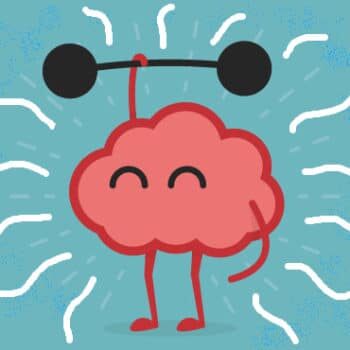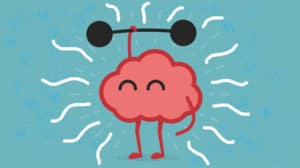The Best Way To Exercise Your Brain

Most people know it is very important to keep our bodies healthy with regular exercise, enough sleep, fresh air, lots of water and nutritious food. Neglecting your body can lead to health problems, fatigue and bad moods. Most people also know that keeping your body healthy can be fun and rewarding too, like playing sports with your friends or having a delicious and filling meal.

However, it is a lesser known fact that our brains require regular exercise too! Unlike your muscles, the brain doesn’t exactly become fitter or stronger when healthy, but builds new connections and releases important chemicals when we take care of it. However, like your body, overlooking your brain’s health can lead to the same poor symptoms. Therefore, it is very, very important to keep your mind in mind!
You may have noticed these symptoms in yourself during quarantine, where lockdown meant your brain was not being stimulated to the level it was used to and was starting to become unfit.
Here at TwistED, we like to know how to keep our brains in shape, and how to do it while having fun! Our activities involve lots of problem-solving and engage our brains, but what are some other ways to keep brain-fit?

There are many ways to keep your brain healthy, and improve things like memory, focus, problem-solving, speed and flexibility. One of these is very obvious, but not everyone’s favourite, school! Learning new things and challenging yourself have wonderful effects on your brain, but sometimes the environment is not fully geared towards achieving this.
There are also a lot of companies in the business of marketing brain-exercising programs and apps, such as Lumosity, which provides daily challenges targeted at improving those above mentioned abilities like memory. However, the University of Illinois actually concluded that these programs and apps provide very little benefit for people’s brains as the skills they develop are not transferable, only specific to the tasks within the program.
My favourite way of exercising my brain, and what I think to be the most enjoyable way, is listening to and playing music. Some studies have even found that playing music the MOST effective way of strengthening your brain. Our brains have evolved, as communication and language evolved, to always be striving to make sense of what we hear, applying patterns to give sound meaning. Humans have very sensitive auditory sensors, a whole system of tiny hairs detecting sound waves, canals to channel sound and things like the eardrum and cochlea. This is very complicated and requires lots of diagrams, so we’ll provide a basic overview!

The system is very carefully curated to detect sound in the form of electromagnetic waves with frequency ranging from 20-20,000 hertz (Hz, referring to the width of the waves sound travels in). Reaching the ear, these signals are translated by the system to reach the brain in the way that we hear things, as sound!
Now that we know how sound reaches us, what happens to the brain and the nervous system when it does? There is an entire field of study dedicated to this, called neuromusicology. Two very important chemicals, or neurotransmitters/neurohormones, are released in the brain when we listen to music we enjoy. The first of these is dopamine, which is widely considered the “motivation molecule” and runs our pleasure-reward systems. Dopamine is stress-reducing and healthy brains have lots of it. Oxytocin is the other chemical released, often named the “trust” or “moral molecule”, making people more trusting or generous. These traits are important in social settings and, once again, healthy brains have no shortage.

Having music playing in the background can increase productivity, energise, improve attention and performance and inspire creativity. In the 1990s, a study coined the “Mozart effect” when it found that exposing young, even unborn, children to music curated by Mozart led to them performing better on intelligence tests.
When listening to music, blood flow to the brain is increased, carrying with it more oxygen, which allows for faster thinking and energises the body. Brains lacking oxygen or with low blood flow are very unhealthy!
The brain works subconsciously on the sounds that it hears to apply a pattern to understand it, and this is what results in the above positive effects.
Even better than listening to music, is actually playing it. For students undertaking musical programs at school, they perform better than their non-musical counterparts in language development, brain connectivity, spatial intelligence and experience a modest increase in IQ.


Musical training actually enacts a physical change in the brain’s structure. This is how the brain strengthens and accommodates for new pathways when it is exercised. The brain’s ability to change shape is called “neuroplasticity”, because it is flexible like plastic! As we age, neuroplasticity becomes harder for the brain, so playing music can slow down neuroplasticity reduction in older brains significantly, as they keep up the practice.
There is a part of the brain called the “corpus callosum” as it is the communicator between the left and right sides of the brain. When we play music, our left and right sides bring their specialties together to orchestrate the movement of muscles, watching the instrument, the song progression, recognising errors and maintaining speed, among other things. Remember that your left-brain is logical and right-brain creative, and we need both of these aspects to make music! It makes sense then that people who play music often have a large corpus callosum allowing the two sides to communicate, as it is regularly exercised and houses more connections than the average non-musical brain.
The volume of grey matter, which is where neurons cluster to achieve muscle control and sensory perception, is also increased in a range of brain areas when music is played frequently.
This structural change leads to functional change, which we see in improved long-term memory, spatial reasoning and faster reaction times, relating to literacy ability. Auditory memory in particular is benefitted and it is used to recall and compare the music being played to its original sound.
Executive functioning in humans refers to our ability to process and retain information, control our behavior, make decisions, and solve problems. Musical training has very positive effects on our executive functioning too.
Neuropsychologist Catherine Loveday says “music reaches parts of the brain that others can’t” and has no doubt about the wonders playing it does to our brains.
Interestingly, the younger people start to play music, the greater the effect the activity has on their brain is. This is likely due to the impressionability of young brains as they grow, and how plastic they are. Children who do 14 months of musical training see these beneficial changes benefit their functioning throughout their lives.

Many historical geniuses were also musicians, the most notorious of those being Albert Einstein, who played the violin throughout his life. Many orchestrators, like Bach, saw mathematical patterns in their music too. We see again how deeply humans endeavour to understand and connect with music.
Overall, it is very obvious how beneficial listening to and playing music is for maintaining a healthy brain, in chemical, physical and functional ways. There’s no point paying $6.99 a week to play “brain training” games when you likely have a guitar or keyboard lying around! The benefits are invaluable and will stay with you into old age. Plus, music is awesome!
– Mardi
